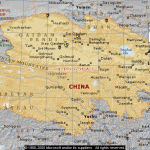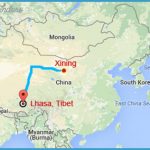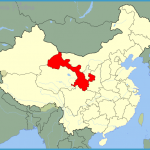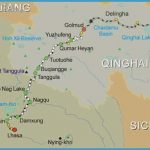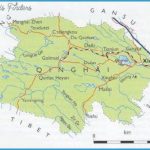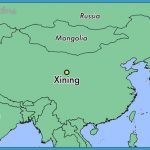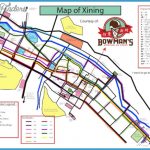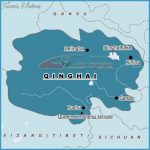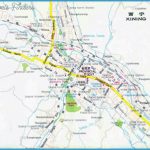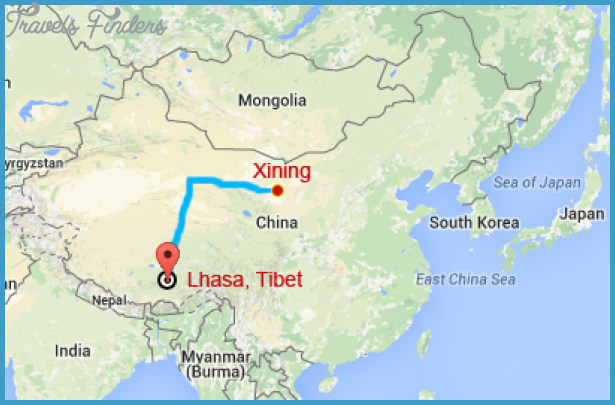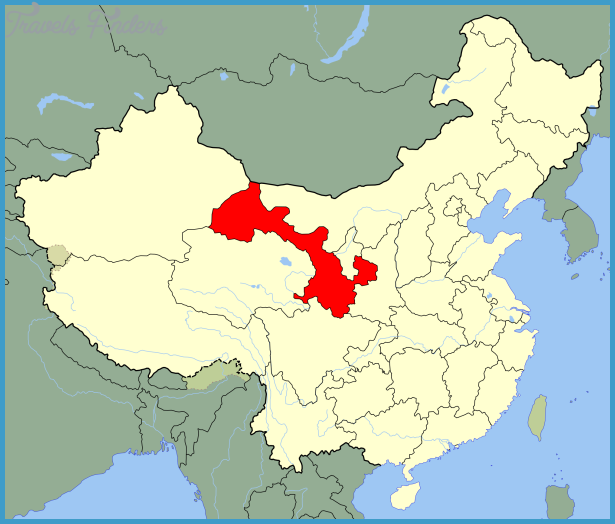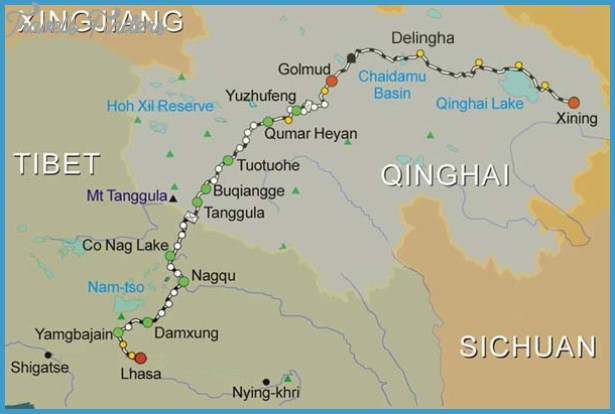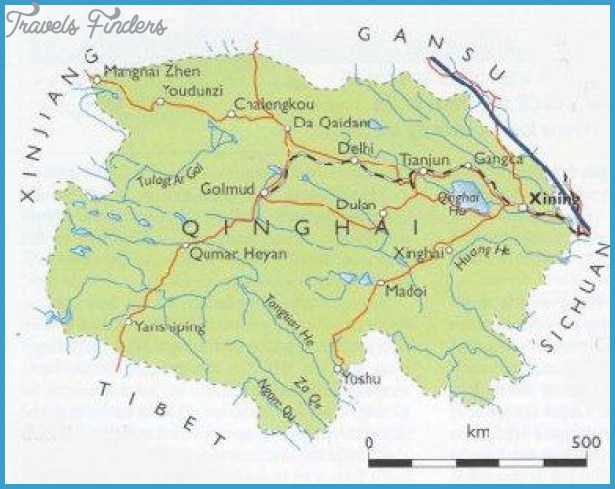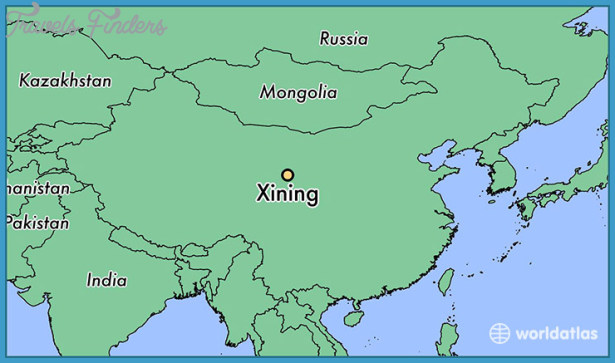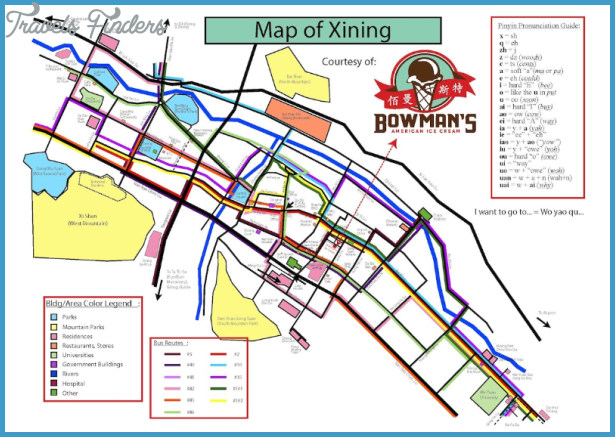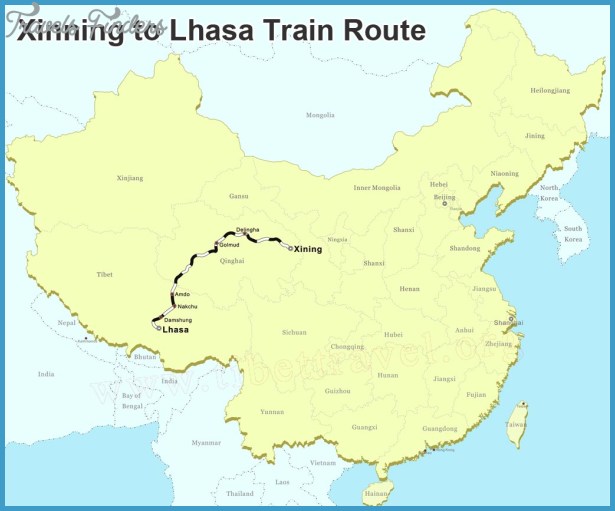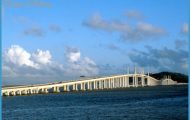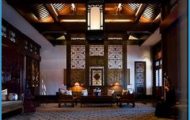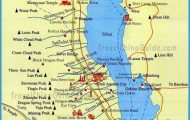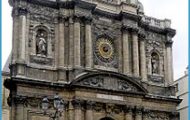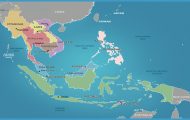Altitude: 2275m/7467ft. Area: 350sq.km/135sq. miles Population: 577,000 (conurbation 910,000)
Xining lies in the north-east of Qinghai province, on the Huangshui river, at 101°42’E and 36°35’N. There are train, bus and air links with Lanzhou, the provincial capital, which is 200km/124 miles away. There are also flights to Beijing (5Y2 hours) and Taiyuan (3Y2 hours).
Xining came into being more than 2200 years ago. Thanks to its strategically favourable situation – one of the few roads to Tibet passed close by it was for centuries a fortress town of considerable importance.
In the transitional period between the Qin and Han dynasties, in the 3rd c. b.c. the town was called Huangzhongdi. It was not given its present name until 1104. In the 1950s the town enjoyed a period of rapid economic development. Today it is the political centre of Qinghai province and an important industrial hub of north-western China.
This mosque in the town centre is built in the Chinese style and consists of a prayer hall 1100sq.m/11,800sq.ft in area, a courtyard of 8400sq.m/ 90,400sq.ft and several ancillary buildings.
In the Lusha’er district, 25km/15V& miles south-west of Xining, lies Kumbum Monastery, built in 1560-77 and covering a total area of 40ha/100acres. It is also known as the Temple ofthe Infinite Number of Pictures ofthe Buddha (Ta’er Si). It is one of the six largest Lamaist temple complexes in China. In the course of various restorations over the centuries Chinese features have been incorporated in the original Tibetan architecture. The latest restoration work was done in 1979. The whole is a giant complex of religious buildings including pagodas, palaces, temples, loggias and monastic cells. A 14m/46ft high stupa stands at the monastery entrance.
Xining
The Small Hall of the Golden Roof (1631) is known for its statues and Small Hall of portraits of Buddhist tutelary gods and for its collection of stuffed animals, the Golden Roof including a horse which belonged to the 9th Panchen Lama (1883-1937). (Xiaojiwna Si)
Originally built in 1606 and later extended, the Hall of the Great Sutra was Hall of the destroyed by fire in 1913 but rebuilt in 1917. Great Sutra
It is here that the lamas assemble to read the scriptures together or to (°ajing Tang) receive religious instruction. The Hall measures 1981 sq.m/21,315sq.ft will hold up to 2000 people. The flat roof of this typically Tibetan edifice rests on 108 square columns encased in priceless tapestries displaying dragon motifs and is decorated with a wheel, the symbol of Buddhist teaching, and with statues of a gazelle and a deer.
The interior is adorned with rolled-up pictures (thangkas), including some applique work – a speciality of the monastery. Visitors can also see
Xining: the mosque
On the monastery forecourt can be seen eight round chortens (the Tibetan form of a stupa, or Buddhist shrine), decorated with high-reliefs; they represent the eight basic phases in the life of Shakyamuni – such as Birth, Victory over the Demons, Nirvana, etc.
The Great Hall of the Gold Roof, the monastery’s principal building, is of three storeys and in the Chinese style. The undulating roof is covered in tiles of gilded bronze. A 11m/36ft tall silver stupa stands in the inner courtyard; it is dedicated to Tsongkhapa (1357-1419), the reformer and founder of the Yellow Cap School (Gelupka). According to legend, he was born here and on the spot where his mother’s blood dripped as she was giving birth to him a sandalwood tree grew, on which could be seen large numbers of pictures of deities and of Tibetan alphabet characters. The mother built the stupa here at the request of her son, who went to live in Tibet. There is a statue of Tsongkhapa in a niche high up in the stupa. Inside, so legend has it, are kept his mother’s placenta and some of his personal belongings, and so it is revered by Lamaists as their holy shrine.
Eight Chortens (Ruyi Dagoba)
Great Hall of the Golden Roof (Dajinwa Si) In Kumbum Monastery some typical examples of local crafts – figures carved in butter, painted textiles and relief embroidery. Bird Island Bird Island lies in the western part of Koko Nor (Lake Qinghaihu), some (Niao Dao) 220km/140 miles from Xining. The large quantities of fish, crabs and aquatic plants provide excellent food for the numerous birds, making the island something of a bird paradise. Between February and March various species of migrating birds from India, South-east Asia, the Mediterranean, the Red Sea and the Caspian Sea join company with the native birds which live on the lake all the year round. The ten or so species of the latter include waterfowl, waders and sparrows. Hunting has been prohibited on the island for a number of years.

